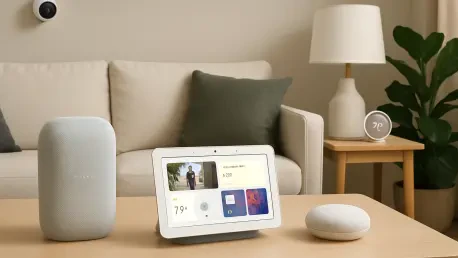Imagine a home where technology anticipates every need—lights dimming as evening falls, air purifiers activating when pollution spikes, and a simple voice command managing it all without a hitch. This vision of effortless living drew a longtime enthusiast to Google’s smart home ecosystem, with Google Home and Assistant promising a connected, automated lifestyle. Yet, over time, this dream unraveled into a tangle of glitches, unfulfilled features, and mounting frustration. What began as an exciting journey into smart living turned into a daily battle against a system that couldn’t keep up with its own hype, leaving the user questioning the very premise of a “smart” home.
Early Promises and Persistent Struggles
Voice Control Breakdowns
The initial charm of Google Assistant’s voice control faded fast as reliability became an elusive goal. Commands that worked one moment would inexplicably fail the next, with delays often stretching long enough to make flipping a switch by hand the quicker option. Error messages like “Sorry, I can’t do that” or “That device isn’t set up” popped up far too often, transforming a feature meant to simplify life into a source of constant irritation. This inconsistency wasn’t just a minor annoyance; it eroded trust in the system’s core functionality, making every interaction feel like a roll of the dice rather than a dependable tool for managing a home.
Beyond the erratic performance, the broader implications of these voice control issues pointed to a fundamental flaw in design. Studies from sources like NPR and Edison Research have noted that smart speakers often excel only at basic tasks—think playing music or reporting the weather—while faltering on complex, multi-step commands. For a user expecting seamless integration across devices, this limitation became a glaring shortfall. The technology, once heralded as the future of convenience, revealed itself as unprepared to handle the nuanced demands of a fully connected environment, leaving sophisticated automation out of reach.
Automation’s Unmet Potential
The deeper disappointment came with Google Home’s failure to deliver on the promise of true automation. The vision was clear: a home where lights adjusted to natural brightness, appliances responded to real-time conditions like air quality, and systems operated in sync without constant oversight. Yet, the platform’s routine editor fell short in critical ways, unable to trigger actions based on key sensor data or integrate essential devices like robot vacuums and cameras. This gap turned ambitious plans for a self-managing home into a frustrating exercise in manual workarounds, exposing how far the system lagged behind its marketed potential.
Compounding the issue was the lack of flexibility in crafting sophisticated routines. Multi-sensor logic, such as sequencing lights based on motion across different zones, remained unsupported, while basic integrations—like notifying when laundry finished—were absent. For a user invested in creating a hands-free environment, these shortcomings weren’t just inconveniences; they represented a betrayal of the smart home concept itself. Instead of a proactive, intelligent system, Google Home offered little more than a glorified remote control, incapable of meeting the needs of anyone seeking genuine automation.
Industry Standards and Growing Pains
Matter Standard’s Rocky Start
When the Matter standard emerged as a beacon of hope for smart home interoperability, expectations ran high for a unified, hassle-free ecosystem. Championed by the Connectivity Standards Alliance, it promised to streamline device integration and bolster security through local control. However, for a dedicated user of Google’s platform, the rollout was anything but smooth. Devices frequently disappeared from apps after pairing, multi-admin setups behaved inconsistently, and network complications, such as IPv6 requirements, created unnecessary friction. Far from simplifying life, Matter introduced a host of new headaches that undermined its core purpose.
Adding to the frustration was the incomplete feature set within Matter’s implementation. Advanced settings often required jumping to manufacturer-specific apps, defeating the goal of a single, cohesive control hub. Without clear error logs or robust support mechanisms, diagnosing and resolving issues became a guessing game. This messy introduction turned a standard meant to eliminate complexity into a source of additional chaos, leaving users to grapple with a fragmented experience that felt like a step backward rather than a leap forward in smart home technology.
Interoperability Challenges Persist
The struggles with Matter reflect a broader challenge within the smart home industry: achieving seamless interoperability across diverse devices and platforms. Even with a standard designed to unify ecosystems, the reality of inconsistent performance and partial functionality created more barriers than bridges. For a user already battling Google Home’s limitations, these integration woes compounded the sense of disillusionment, as the technology failed to deliver on its promise of harmony. The need to juggle multiple apps and troubleshoot obscure errors only deepened the frustration with a system that should have been intuitive.
Moreover, this experience underscores an industry-wide hurdle that extends beyond any single platform. The push for universal standards like Matter, while well-intentioned, often stumbles in early adoption phases due to incomplete support and varying manufacturer commitments. For users seeking a plug-and-play solution, these growing pains translate into real-world setbacks, where the dream of a connected home remains just out of reach. Until these foundational issues are resolved, the gap between expectation and execution will continue to alienate even the most patient tech enthusiasts.
Exploring Alternative Solutions
Embracing Zigbee for Reliability
Fed up with Google’s persistent shortcomings, a significant shift to alternative technologies like Zigbee offered a much-needed reprieve. Known for its low-power mesh network, Zigbee delivered the reliability that Google Home lacked, enabling faster and more consistent automations without the constant hiccups. The transition wasn’t just a technical fix; it represented a reclaiming of control over a home environment that had become unpredictable. Cost-effective sensors and a robust framework further sweetened the deal, proving that dependable performance didn’t have to come with a steep price tag or endless frustration.
The benefits of Zigbee extended beyond mere stability to a deeper sense of empowerment over smart home management. Unlike the opaque operations of mainstream platforms, this alternative provided clearer visibility into system interactions, making it easier to pinpoint and address issues. For a user disillusioned by Google’s black-box approach, this transparency was a game-changer, allowing for precise adjustments and integrations that were previously impossible. The move highlighted a stark truth: sometimes, stepping away from big-name solutions opens the door to more practical, user-friendly options.
Home Assistant as a Game-Changer
Complementing the shift to Zigbee, adopting Home Assistant as a central control hub marked a turning point in achieving a truly functional smart home. This open-source platform offered unparalleled flexibility, integrating a wide array of devices—from desk motors to alarm systems—that Google Home overlooked. With detailed logs for troubleshooting and the ability to execute localized automations, Home Assistant stood in sharp contrast to the restrictive, error-prone experience of its predecessor. The result was a system that finally aligned with the vision of seamless, hands-free operation.
Equally impressive was Home Assistant’s capacity to adapt to complex needs without sacrificing usability. Users could craft intricate routines based on multiple triggers and conditions, something Google’s routine editor couldn’t dream of supporting. This granular control, paired with a community-driven approach to updates and compatibility, addressed the very gaps that had driven frustration with mainstream offerings. Industry insights, such as IDC reports on smart home product churn due to interoperability issues, reinforce the appeal of such customizable solutions, showing a clear demand for platforms that prioritize function over flash.
Reflecting on Industry-Wide Issues
Discontent Among Advanced Users
The pivot away from Google’s ecosystem mirrors a growing unrest among power users who find mainstream smart home platforms lacking in depth and reliability. While these systems often cater well to casual needs—simple voice commands or single-device control—they consistently fall short for those aiming to build sophisticated, multi-layered automations. This dissatisfaction isn’t an isolated grievance; it reflects a broader trend where tech-savvy individuals seek out solutions that can handle the complexity of a fully integrated home without constant failures or limitations.
This trend also ties into wider industry observations about the state of smart home technology. Reports frequently highlight how many platforms struggle with advanced tasks and interoperability, even as they market themselves as all-in-one solutions. The result is a divide between casual adopters, who may be content with basic features, and advanced users, who feel compelled to explore alternatives for the control and stability they crave. Until major players address these deeper needs, the migration to niche, adaptable systems will likely continue to gain momentum.
Automation and Energy Efficiency Gaps
Another critical angle to this discontent is the missed opportunity for smart homes to drive meaningful energy savings through effective automation. Research from groups like ACEEE suggests that well-implemented systems could reduce HVAC energy use by 10-15%, but only if devices and routines work in harmony to respond to real-time conditions. Google’s inability to integrate key sensors or execute predictive automations squanders this potential, leaving users with inefficient setups that barely scratch the surface of what’s possible in energy management.
This failure isn’t just a user inconvenience; it’s a systemic issue that hampers the broader adoption of smart home tech as a tool for sustainability. When platforms can’t deliver on adaptive, context-aware functionality, the promise of reduced energy footprints remains unfulfilled. For an industry aiming to position itself as a cornerstone of modern, eco-conscious living, closing these gaps in automation capability is essential. Without progress, the technology risks being seen as a novelty rather than a transformative force for efficiency and environmental impact.
Path Forward for Smart Home Tech
Enhancing Routine Functionality
Looking back, the critiques of Google’s smart home platform revealed a clear need for expanded routine capabilities that had been overlooked for too long. Supporting all device classes and sensor data—whether for air purifiers, cameras, or vacuums—stood out as a necessary step to bridge the gap between vision and reality. Had Google prioritized these integrations earlier, users might have experienced a system that truly automated daily life rather than one requiring constant manual intervention. Reflecting on past shortcomings, the call for comprehensive routine options became a cornerstone for improvement.
Equally important was the push for intuitive tools to design and manage these routines. Past frustrations stemmed from rigid editors that couldn’t accommodate nuanced triggers or multi-step logic, leaving ambitious setups unrealized. A more flexible, user-friendly approach to automation design could have transformed the experience, making smart homes accessible to both novices and experts. Reflecting on these missed opportunities, it became evident that empowering users with robust tools was critical to rebuilding trust in the platform.
Prioritizing Local Control and Matter’s Promise
Additionally, past efforts fell short without a strong focus on local automation and reliable diagnostics, areas that had been neglected in favor of cloud-dependent features. Emphasizing local processing with detailed error logs would have allowed quicker responses and easier troubleshooting, addressing a core frustration for many. Looking at what could have been done, a commitment to localized control emerged as a vital lesson from earlier missteps, offering a path to more dependable performance.
Finally, the rocky history with Matter’s implementation underscored a need for full commitment to its vision of interoperability that hadn’t been achieved. Ensuring seamless multi-admin support and complete feature sets within Google Home—or at least clear guidance on when manufacturer apps were needed—could have prevented much of the chaos users faced. Reflecting on those challenges, the next steps involve refining Matter’s integration to eliminate friction and deliver on its unifying potential. Moving forward, Google and similar platforms must invest in these areas to turn past failures into future successes, creating smart homes that genuinely live up to their name.









